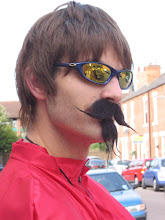As you know, I like a bit of history.
I didn't actively go out seeking history on our holiday in Dartmoor last week... well, I suppose I did a bit: visits to castles and various National Trust properties probably count as seeking out history right? Well, anyway. I accidentally stumbled across some history as I was browsing the little shops in the centre of Chagford.
There's a little art gallery there, and it seemed to have an unusual number of pictures and sculptures of hares. Now, I like hares. They're beautiful and interesting animals. To this day, I regret that we didn't buy a lovely ceramic sculpture of a hare that we saw when we were in a cafe in Ashbourne. I paused to have a closer look at the pictures in the gallery, and saw that there was a leaflet there too about something called "The Three Hares Trail". It turns out that there are a number of churches - seventeen, to be precise - around Dartmoor that all have at least one roof boss depicting an ancient symbol of three hares or rabbits running in a circle and joined by their ears to form a triangle at the centre of the design. The symbol is a puzzle for each creature appears to have two ears yet, between them, they share only three ears. I was intrigued, and as one of the seventeen churches was in Chagford itself, I headed over to have a look.
The symbol in Chagford is on the roof directly over the altar. The little flyer detailing the history of the church that I picked up on the way in explained that the hares or rabbits were often associated with the tin miners in the area (who bred rabbits in warrens for food) and that the three represented the Trinity.
Hmm. The leaflet I'd picked up in the gallery had mentioned that the three hares symbol can be found all over the world and many thousands of miles apart. According to the Three Hares Project, the earliest known examples of the motif date back to the 6th Century AD and are on the ceilings of Buddhist cave temples in Dunhuang, China - an important trading post. The symbol is also associated with Buddhism, Islam and Judaism as well as Christianity. Not to mention the fact that the hare itself is an animal with strong links to magic and to paganism and has long been associated with fertility, the moon and the female reproductive cycle.
A sign of the Trinity? Perhaps, but it feels as though there are other meanings going on here too and that the symbol's presence in these churches does not have such a straightforward interpretation.
Later that same day, we went out to Widecombe-on-the-Moor to have a look at the church there and to go for a walk on the moor. There's a boss of the three hares on the roof there too, again close to the altar. Again, the literature in the church itself links this to the Tin Miners (who paid for the addition of the famous church tower) and with the Trinity. Looking at the positioning of the boss on the ceiling here, and it is surrounded by other bosses representing images that don't seem at all Christian to me: there are several Green Men, a boss featuring Gawain (of Green Knight fame, of course), bosses of Oak, Wormwood and Myrtle.
The boss of the hares here itself is called "The Hunt of Venus"... is it just me who thinks that the whole Trinity explanation of the significance of this symbol has been added somewhat after the event? The whole thing reeks of paganism. Not that this is a bad thing.... surely the story of Christianity is, above almost all else, a story of the triumph of adaptability? Where do you think the Easter Bunny comes from? Or the Christmas Tree? Or the celebration of Christmas around Midwinter? These links to paganism are not to be feared or explained away, surely they're to be celebrated?
We went to a family wedding in Tavistock on the Saturday, and funnily enough there was a boss with the three hares there too, only this time the creatures depicted were categorically rabbits. I suppose they superficially look the same, but anyone who has ever seen a hare with their own eyes will know that they're unmistakably hares and not rabbits. These were rabbits.
Still, I was intrigued by the little slice of history that I'd stumbled across. Every day is a school day.
Especially if you're a history geek. It's everywhere and it's brilliant.
Open the mic
1 week ago





Hares are cool, definitely. The whole trinity thing is such a rip off, three has been the magic number since the year dot and Christians just had to have something to fit in with that. God is God, obviously. Jesus is the son of god, okay, I can go with that. But the Holy Ghost? Who's he? What exactly is his USP?
ReplyDeleteYeah - the Holy Ghost is just along for the ride! Mary must look at him and think that she does a lot more of the heavy lifting and is nowhere near that dude's pay grade. Freeloader. A dove? He's basically a wheezy pigeon with manky feet, for all he brings to the party.
ReplyDeleteHares have a look that you see most often in cats: it's a real 'Yeah, and?" kind of a look. A real "fuck you" look. I like it.
ReplyDeleteI agree, this is another case of the church trying to assimilate pagan religion and symbology in an attempt to stamp paganism out. This was really interesting.
ReplyDeleteAnd yes, the last were rabbits, not hares.